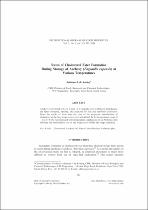 ResearchSpace
ResearchSpace
Rates of cholestrol ester formation during storage of anchovy (Engraulis capensis) at various temperatures
JavaScript is disabled for your browser. Some features of this site may not work without it.
- ResearchSpace
- →
- Research Publications/Outputs
- →
- Journal Articles
- →
- View Item
| dc.contributor.author |
De Koning, AJ

|
en_US |
| dc.date.accessioned | 2007-03-16T08:11:07Z | en_US |
| dc.date.accessioned | 2007-06-07T10:02:35Z | |
| dc.date.available | 2007-03-16T08:11:07Z | en_US |
| dc.date.available | 2007-06-07T10:02:35Z | |
| dc.date.copyright | en_US | |
| dc.date.issued | 2004-07 | en_US |
| dc.identifier.citation | De Koning, AJ. 2004. Rates of cholestrol ester formation during storage of anchovy (Engraulis capensis) at various temperatures. International Journal of Food Properties, vol. 7(2), pp 321-327 | en_US |
| dc.identifier.issn | 1094-2912 | en_US |
| dc.identifier.uri | http://hdl.handle.net/10204/1965 | en_US |
| dc.identifier.uri | http://hdl.handle.net/10204/1965 | |
| dc.description.abstract | Anchovy were stored at 17, 8, 0 and -6 degrees C. Samples were withdrawn periodically, the lipids extracted, purified, and analysed for free and esterified cholesterol. From the results of these tests the rates of the enzymatic esterification of cholesterol at the four temperatures were calculated. In the temperature range of -6 to 17 degrees C the rate increased with temperature. Application of an Arrhenius plot afforded the esterification rate at any temperature within the range examined. Enzymatic formation of cholesterol ester from free cholesterol has been shown to occur during spoilage of anchovy (Engraulis capensis). As a result, the quality of the oil produced from the fish is reduced, as esterified cholesterol is much more difficult to remove from the oil than free cholesterol. However enzymatic esterification of free cholesterol during spoilage of anchovy in the delay between catching and processing adversely affects the quality of the resulting anchovy oil since, in contrast to free cholesterol, esterified cholesterol is only removed with difficulty. This is a serious problem for anchovy rich oils, which are rich in omega-3 fatty acids and used as dietary supplements, since these oils should have little total cholesterol. The present investigation has shown that esterification is very temperature-dependent; for instance the rate at 17 degrees C is 16 times that at 0 degrees C. Icing the fish in the delay period is therefore very effective in reducing the progressive esterification of cholesterol. | en_US |
| dc.format.extent | 115208 bytes | en_US |
| dc.format.mimetype | application/pdf | en_US |
| dc.language.iso | en_US | |
| dc.publisher | Marcel Dekker | en_US |
| dc.rights | Copyright: 2004 Marcel Dekker inc | en_US |
| dc.source | en_US | |
| dc.subject | Anchovy oil | en_US |
| dc.subject | Engraulis capensis | en_US |
| dc.subject | Esterification rate | en_US |
| dc.subject | Cholesterol ester | en_US |
| dc.subject | Enzymes | en_US |
| dc.subject | Biological chemistry | en_US |
| dc.title | Rates of cholestrol ester formation during storage of anchovy (Engraulis capensis) at various temperatures | en_US |
| dc.type | Article | en_US |
| dc.identifier.apacitation | De Koning, A. (2004). Rates of cholestrol ester formation during storage of anchovy (Engraulis capensis) at various temperatures. http://hdl.handle.net/10204/1965 | en_ZA |
| dc.identifier.chicagocitation | De Koning, AJ "Rates of cholestrol ester formation during storage of anchovy (Engraulis capensis) at various temperatures." (2004) http://hdl.handle.net/10204/1965 | en_ZA |
| dc.identifier.vancouvercitation | De Koning A. Rates of cholestrol ester formation during storage of anchovy (Engraulis capensis) at various temperatures. 2004; http://hdl.handle.net/10204/1965. | en_ZA |
| dc.identifier.ris | TY - Article AU - De Koning, AJ AB - Anchovy were stored at 17, 8, 0 and -6 degrees C. Samples were withdrawn periodically, the lipids extracted, purified, and analysed for free and esterified cholesterol. From the results of these tests the rates of the enzymatic esterification of cholesterol at the four temperatures were calculated. In the temperature range of -6 to 17 degrees C the rate increased with temperature. Application of an Arrhenius plot afforded the esterification rate at any temperature within the range examined. Enzymatic formation of cholesterol ester from free cholesterol has been shown to occur during spoilage of anchovy (Engraulis capensis). As a result, the quality of the oil produced from the fish is reduced, as esterified cholesterol is much more difficult to remove from the oil than free cholesterol. However enzymatic esterification of free cholesterol during spoilage of anchovy in the delay between catching and processing adversely affects the quality of the resulting anchovy oil since, in contrast to free cholesterol, esterified cholesterol is only removed with difficulty. This is a serious problem for anchovy rich oils, which are rich in omega-3 fatty acids and used as dietary supplements, since these oils should have little total cholesterol. The present investigation has shown that esterification is very temperature-dependent; for instance the rate at 17 degrees C is 16 times that at 0 degrees C. Icing the fish in the delay period is therefore very effective in reducing the progressive esterification of cholesterol. DA - 2004-07 DB - ResearchSpace DP - CSIR KW - Anchovy oil KW - Engraulis capensis KW - Esterification rate KW - Cholesterol ester KW - Enzymes KW - Biological chemistry LK - https://researchspace.csir.co.za PY - 2004 SM - 1094-2912 T1 - Rates of cholestrol ester formation during storage of anchovy (Engraulis capensis) at various temperatures TI - Rates of cholestrol ester formation during storage of anchovy (Engraulis capensis) at various temperatures UR - http://hdl.handle.net/10204/1965 ER - | en_ZA |





